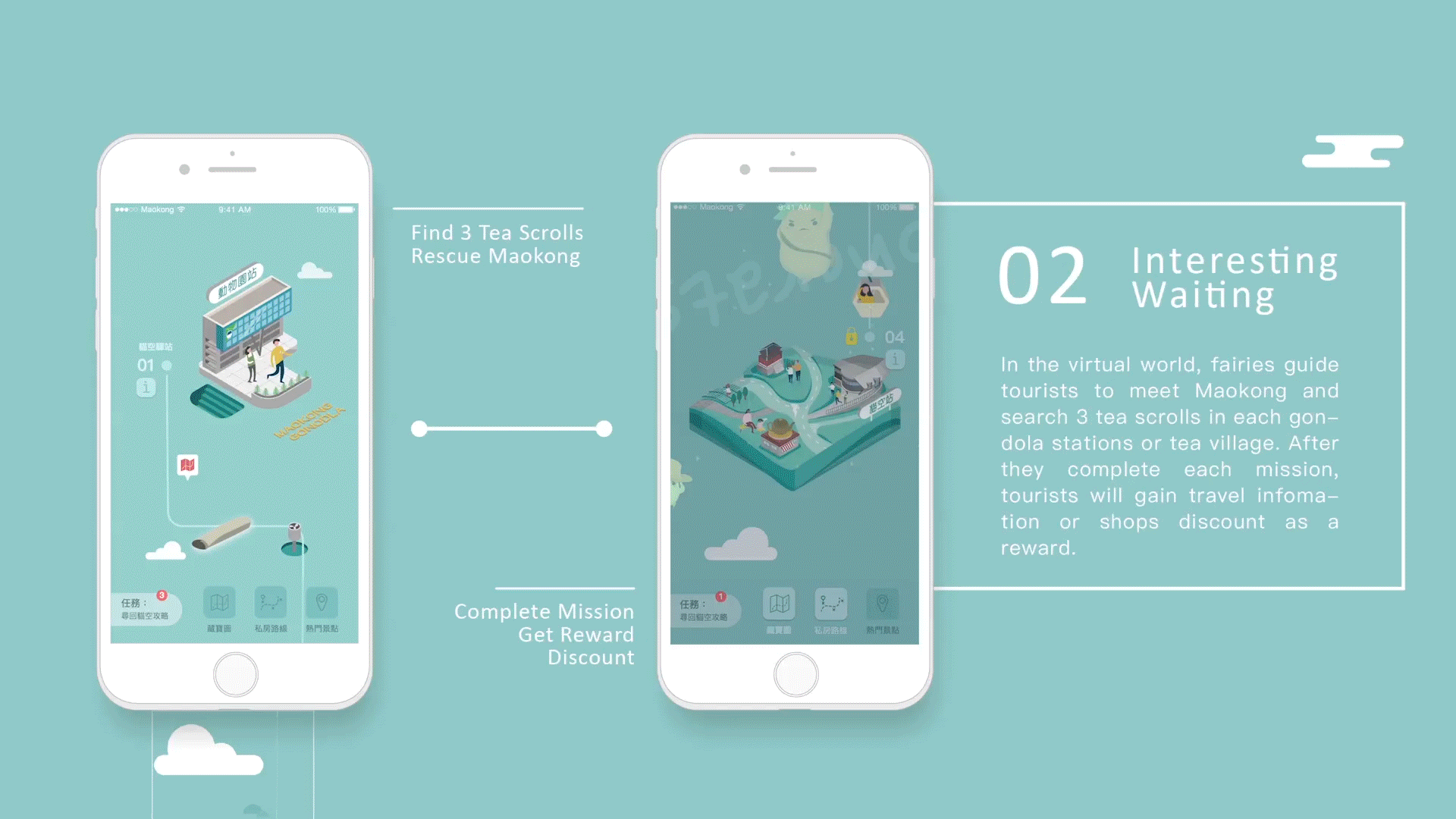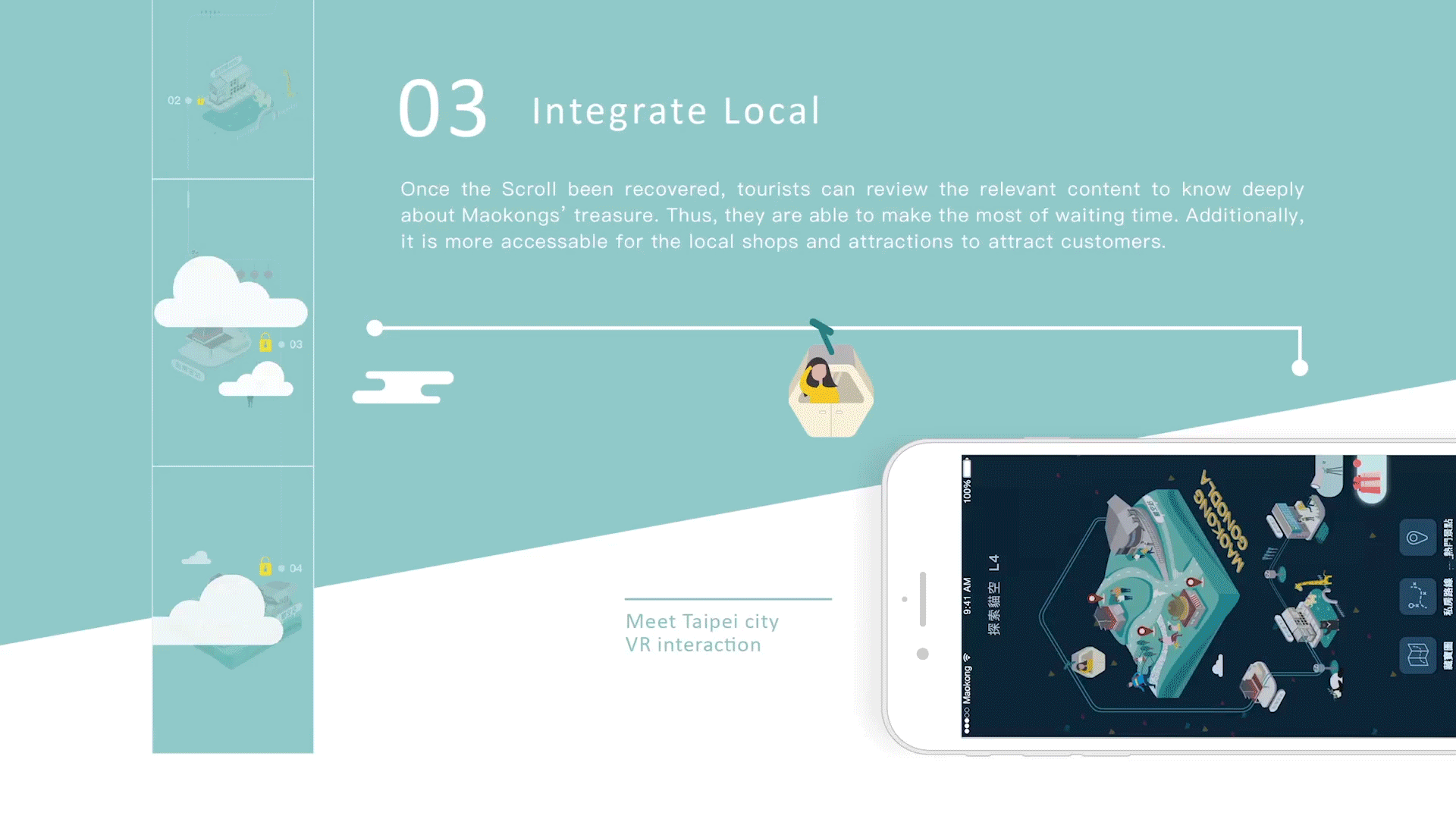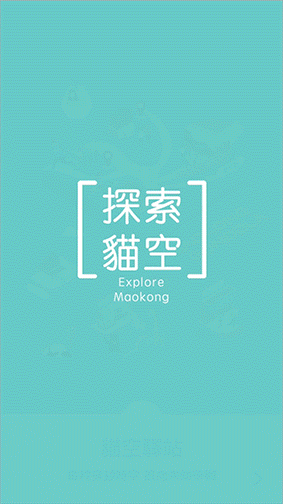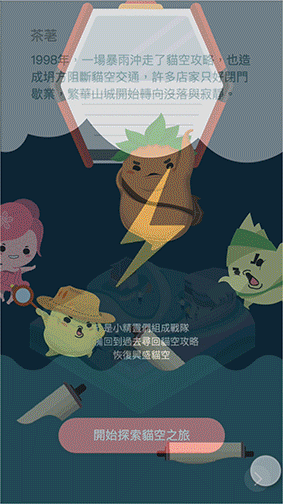top of page

July 2015 ~ July 2017
EXPLORE MAOKONG
O2O TOURISM GUIDE
Elevates Maokong Gondola from serving a transportation function to a travel orientated service by the means of building up a network system with tourists and local tourism.
OVERVIEW
BACKGROUND
An operating deficit increased the burden
Maokong Gondola, the longest cable-car system in Taiwan, has led Maokong, a quaint village which is rich in culture and natural resources, to become an international tourism destination. Nevertheless, in recent years, with the decline in the number of tourists, it increased the burden on Maokong Gondola and even drove local tea restaurants out of business. Because of a substantial operating deficit, the Gondola fares went up by at least 240%. With the strategy of the considerable price increase, it is essential to take measures on provide better tourism experience and enhance transport service to attract customers.
PROJECT GOALS
- Strengthen existing tourists’ revisit opportunities
- Engage first-time tourists
RESEARCH PROCESS
Discover:Initially mapped the whole travel journey of Maokong Gondola tourism service through shadowing, then employed the Critical Incident Technique and discovered 13 service gaps.
Define:Began with an interview with the service provider to confirm the finding. Further, 4 key service gaps were identified to illustrate the design principle through a co-create workshop.
Design:Design method and tools, such as customer journey map and wireframe, were created to explore user experience. Then, users were involved to paper and digital prototype, its user testing feedback facilitates iterative design and improving usability.
Deliver:By storytelling, creating interesting waiting experience, and integrating local, Explore Moakong O2O Tourism Guide filled 3 critical service gaps in the existing service. Additionally, it facilitates tourists to travel in-depth and finally improves tourism satisfaction.



A. DISCOVER
COLLECTED UNSATISFIED INCIDENTS
REVEALED EXISTING PROBLEM
Anchor 3
1. Mapped Customer Journey
Method - Shadowing
To identified the whole travel process, two tourists were invited on the internet to assess the existing service. I observed and documented the tourists' interactions without interference. Based on the result, the journey of Maokong Gondola service was mapped with the information about touchpoints, tourist behaviour the relevant photos.

Shadowing- observe
riding Gondola

Shadowing- observe
traveling in Maokong

Shadowing- observe
the tourists in the service environment

Shadowing- observe
riding Gondola
1/4
2. Discovered Service Gaps
Method - Critical Incident Technique
I interviewed a total of 101 respondents. Most of the respondents were able to concretely express their "most" satisfied and unsatisfied incidents (including the description of interaction scenarios and emotions or feelings) with the "visualized " customer journey card. It can stimulate the respondents to recall and describe the critical incidents that they have experienced in detail.

B. DEFINE
IDENTIFIED 4 KEY SERVICE GAPS
CO-CREATE PROBLEM-SOLVING PRINCIPLE
FINDINGS
The result of data analysis finally dug out 13 service gaps.
It shows that tourists feel most unsatisfied when they are queueing up inside the station and riding the Gondola.

Anchor 2

1. Synthesized Stakeholder's Insights
Method : Interview
In order to understand what reason result to these service gaps from the viewpoint of the service provider, we interviewed them and shared the finding. By confirming service gaps and the future development of Maokong Gondola, it facilitates us creating a new service with high implementation.

2. Co-Created Innovation Service Value
Method - Co-Creation Workshop
Based on the research and stakeholders' insights, we employed some service design tools, and eventually identified 4 service gaps and generated new service concept with 2 tourists and 2 service designers.

(1) Defined Critical Service Gaps
Tool : Priority Matrix
Why
Prioritized 13 service gaps to focus on the high-value activities.
What we did
According to stakeholder's capacity and expectation, we sorted each service gap by discussing 2 questions in a 2x2 matrix :
- Is it " feasibility " for the service provider to fill the gap?
- Will it generate high " significant " value to stakeholders?

(2) Brainstorming Ideation
Tool : KJ-Method
Why
Create ideas, uncover opportunities in a short time.
What we did
- listed individual ideation onto post-it notes and stick them to relevant
touchpoints. If others are inspired could combine their ideas together.
- Organized memo by relationship
- Established group priorities through discussing and voting.

(3) Proposed Value Proposition
Why
Ensure the final service that can fill the relevant service gap, meet the needs of each stakeholder.
What we did
- Identified the needs of 3 core stakeholders, including 1) Maokong
Gondola; 2) local shops, attractions and 3) tourists.
- Created the value proposition according to their needs and ideation.
RESULTS
1. Defined 4 Critical Service Gaps
2. Defined New Service Principles
We’ve since used the following principles to align our design critiques, shape a collective voice across design in the workshop, and as the foundation for the further service design.



Anchor 4
C. DESIGN
ITERATIVE PROTOTYPING
BRINGS USER EXPERIENCE TO LIFE

Identify new user experience

貓空_170921_0015.jpg

Identify new user experience
1/2
Empathised With User
Engaged Their Experience
Persona → Scenarios → Customer Journey Map
Based on field research, we illustrated a typical persona, a tourist travel with their family in Maokong, and generated scenarios and CJM to design new service experience. It helps me to understand the conceptual story about a user's interaction with new service, and their thought during the journey.

Functional map.jpg

User flow

Wireframe

Functional map.jpg
1/3
Builded a Flow
with Users in Mind
Functional map → UI flow → Wireframe
In the beginning, I illustrated a functional map and UI flow to explore the information architecture. Following, the hand drawing wireframe was generated to show how the user interacts with the page and where the page should lead to. It enabled the service to be rapidly designed, and also helped me to communicate ideas with users and other designers.

Paper prototyping

Digital Portotyping

Paper prototyping
1/2
Refined Ideas with Users
Paper prototyping→ Digital prototyping
I first created the paper prototype to test the human interaction with user interfaces. By user testing feedback, it facilitates the quick introduction of modifications and refinements to fix usability problems that have been identified. Further, the digital prototype of the refined design was made on Flinto and was tested on real mobile devices.
D. DELIVER
EXPLORE MAOKONG
O2O TOURISM GUIDE
Elevates Maokong Gondola from serving a transportation function to a travel orientated service by the means of building up a network system with tourists and local tourism.
01 Storytelling
02 Waiting experience
03 Integrate local
Anchor 1
Customer Journey Map












ASSESS
Method : Experience Prototype x Critical Incident Technique
To examine and verify the new service, tourists were invited on the internet to assess the new service design through Experience Prototype in Maokong Gondola. Again, I employed the CIT approach to discover critical incidents and identify the differences of the critical incidents between the existing service and Explore Maokong O2O Tourism Guide to uncover the effects.
RESULTS
1. RISED TOURISM SATISFACTION

Before offering new service design, 57% unsatisfied incidents were mentioned by tourists that shows the travel interfered with numerous service failures in the existing journey. However, when the Maokong Gondola offering the service of Explore Maokong, the rate of satisfied incidents increased dramatically by 22 %. In other words, the new service improves problems and provides more impressive touchpoints for tourists that make them feel satisfied and memorable.
2. Filled 3 Critical Service Gaps
After comparing the proportion of critical service of two services, the data illustrated that the design feature, 1) Storytelling, 2) Interesting waiting experience and 3) Integrate local, of Explore Maokong App has filled 3 Critical service gaps successfully. However, it failed to solve 1 service gap, Attraction Information :

Solved Problem :
- Queue Time : Interesting waiting experience evokes tourists' eager anticipation, then make them pay less attention to boring wait time.
- Gondola Atmosphere : The App can be a conversational entrance and facilitated interactions among travel companions.
- Meal Information : Integrate local facilitated tourists to explore the local tea meal which is unique and fascinate tourists the most.
Unsolved Problem :
- Attraction Information : Although the App provides tourism information for tourist, the Maokong tourism area ( station, gondola, road ) still lacking attraction signage that builds barriers to in-depth travel for tourists and generates more unsatisfied incidents. Thus, the service design should improve with the real environment instead of merely making changes on the device.
IMPACT
Reduce Perceived Wait Time
Compared with existing service, the collected unsatisfied incidents of new service design in the stage of Queue up dropped by 8.2%. By contrast, the figure for satisfied incidents raised up from 22% to 35.3%.
Boost Interpersonal Interaction
When riding a gondola in existing service, tourists may feel awkward to ride with strangers, accounting for 3.9%. When it comes the stage of new service design, the interaction with travel companions is a dominant satisfied incident (5.16%).
Spark Off In-depth Travel
Maokong Gondola is elevated from serving a transportation function to a travel orientated service, it builds up a network system with tourists and local tourism. The number of satisfied incidents in the stage of travel in Maokong changed dramatically, rising from just about 4% in existing service to over 37% in new service design.
YOU MAY BE INTERESTED IN
bottom of page



